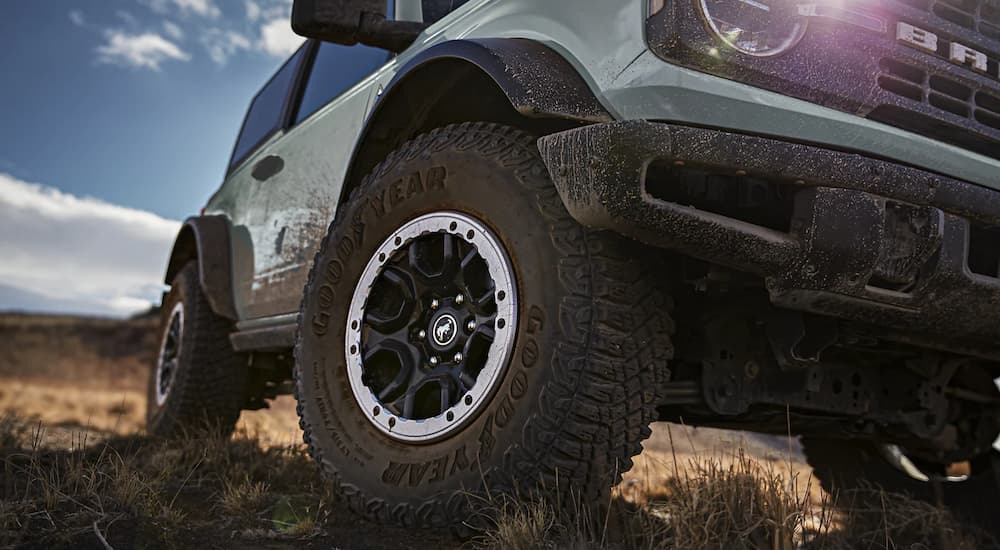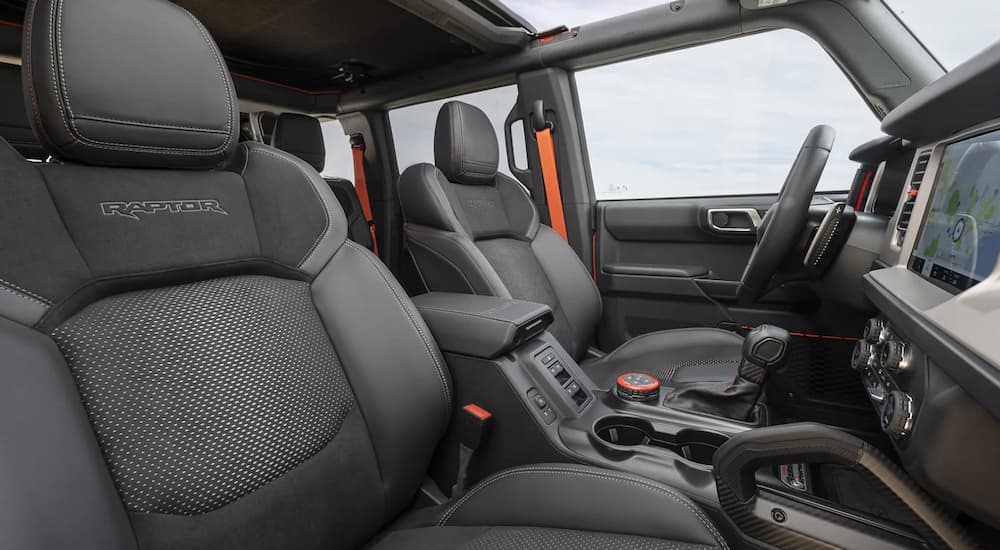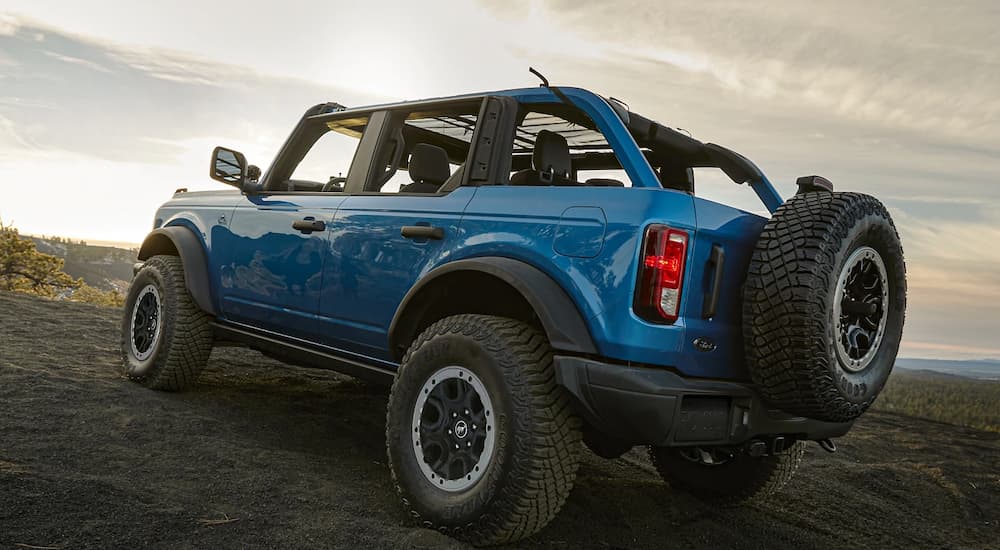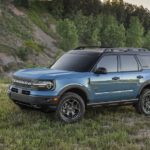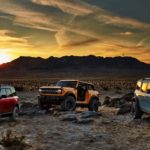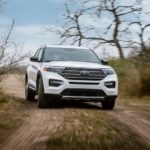Off-roading is not a new concept. In fact, the first vehicle capable of tackling such terrain was thought up more than 100 years ago. However, it pales in comparison to the off-roading monsters we have today, like the 2023 Ford Bronco. That isn’t very surprising since we have had 100 years’ worth of innovation to get to where we are now. With all these improvements, many of the features that simplify off-roading are confusing to the novice. That’s why we are diving in, tires first, to explore some of the most important features for off-roading and what exactly they do.
The 2023 Ford Bronco was designed with off-roading in mind. From top to bottom, it has some of the most essential features for the adventurer, but unless you are familiar with the lifestyle, their purpose may not be clear. An off-road vehicle needs to be able to overcome many situations, like rocky terrain, sticky mud, and deceptively deep puddles. To do this, it needs to be equipped with a multitude of features that can work together to get you through an array of scenarios.
Differentials Make a Difference
When taking on the trails, you can encounter anything from rock and sand to mud and even snow. Traction plays a significant role in overcoming such elements. That’s where electronic front-and rear-locking differentials come in. At first, it may sound complicated, but really, it’s a simple concept that can mean the difference between moving forward or falling behind.
The 2023 Ford Bronco is decked out with some serious gear in the form of the Dana AdvenTEK M210 independent front suspension and the Dana 44 AdvenTEK M220 solid rear differential with both front and back sporting a Spicer Performa-TraK electronic locker. To start, we can focus on what it means to have an independent front suspension. Since the front suspension is independent, the axle shafts on either side of the vehicle can move separately when encountering impediments. Imagine one side of your vehicle being able to climb over a large boulder with minimal disruption to the other side of the SUV.
An independent front suspension equates to better articulation in the joints, which means improved control when going off-road. Additionally, independent suspension typically means a smoother and more comfortable ride since it can take on impact easier. The rear of the Bronco, however, is equipped with a solid rear differential, which means the whole assembly is encased in a single unit. This type of assembly is stronger and can stand up against impact.
Both the front and rear are also outfitted with an electronic locker. An electronic locker allows you to flip a switch and lock both the front and rear differentials. When locked, the left-side wheels and the right-side wheels will move with the same speed and torque. This is not ideal for normal driving because having some give is good for cornering and other typical driving behavior. However, if you are in a “slippery” situation, forcing both sides to move equally could be the extra boost you need to gain traction.
G.O.A.T. Modes
Technology plays just as big of a role in off-roading as mechanics, which is why having a vehicle with G.O.A.T. modes are so important. G.O.A.T. stands for “Goes Over Any Type of Terrain” and is a clever way of indicating your SUV has different drive modes for improved handling on and off-road landscapes. Many vehicles have Sport, Normal, and Eco modes, but rugged rebels like the Bronco have a lot more. On top of the three main modes that most vehicles nowadays have, the Bronco also features Slippery, Sand/Snow, Mud/Rut, Rock Crawl, Baja, Tow-Haul, and Off-Road modes.
Slippery mode adjusts the throttle and shifting to help control vehicle response. By lowering the throttle response, the vehicle will account for slick conditions and will control acceleration to minimize tire slippage. The program also optimizes shifting, which means the algorithm decides when to shift to a specific gear to maintain the best traction.
Sand/Snow mode allows the vehicle to engage and disengage its electronic four-wheel lock to optimize control. By locking and unlocking all four wheels when the program sees fit, you can avoid tire slippage and gain traction as needed. This is the first step in the Mud/Rut mode as well. However, Mud/Rut mode also adjusts traction and stability controls to allow for necessary movement in the tires. Traction control will kick in when it feels like it is slipping, but in some situations, you don’t want traction control, and that’s where this mode comes in.
Rock Crawl mode provides additional security by not only engaging the locks but also using a camera at slower speeds to prepare you for surrounding obstacles. Baja mode, much like Slippery mode, optimizes the throttle, so you have better control while driving at higher speeds in off-road conditions. Tow-Haul mode reduces transmission shifting for a smoother tow and can apply braking as needed on slopes.
The final mode is Off-Road mode, which uses the existing traction and stability controls that come equipped to give you grip and flexibility where needed. Many of the modes use existing features on the vehicle that could be turned on or off by the driver, but with a complex program making the decisions, you will have a quicker response when needed. Knowing when to use specific modes increases the value you get from your vehicle.
Tailored for the Trail
The Bronco comes equipped with certain programs that make off-roading easier and safer than ever before. One such program is Trail 1-Pedal Drive which allows you to control the speed of the vehicle with the accelerator pedal only. Pressing down on the accelerator works as expected, but once you let off the accelerator, 1-Pedal engages the brake. Let your foot off entirely, and the Bronco will come to a complete stop.
Trail Turn Assist is another off-roading feature that maximizes your experience. Trail Turn Assist engages the brakes for the inside rear wheel when at low speeds to tighten the turning radius. With easier maneuverability in tight corners, you will be able to go more places with ease.
Ford also equips many of their rugged vehicles with Trail Control. Trail Control hands over more control to your Bronco so you can spend more time focusing on the trails. The system can be used at lower speeds and will allow you to select a specified acceleration, which it will then maintain by engaging brakes and gas when needed.
Clear to Keep on Rolling
You can’t take any vehicle off-road and expect it to survive the conditions thrown at it. A car needs not only to be equipped with off-road tools but also to be designed for off-roading. Being built with off-road-focused engineering means the Bronco can clear obstacles easier than the average SUV.
For instance, having proper ground clearance is extremely important for crawling over rocks, wading through water, or clearing large hills. The more clearance, the more obstacles you can conquer. The Bronco sports 11.6 inches of ground clearance, which is ideal for more extreme conditions. Additionally, it has been designed with the engine sitting high so that wading through water won’t bog you down. In fact, you can wade through up to 33.5 inches of water before you encounter issues.
How your SUV is designed to handle approaching, going over, and leaving obstacles also plays a significant role in how good your vehicle will be as an off-roading companion. The Bronco has a break-over angle of 29 degrees. The break-over angle looks at the lowest part of the vehicle between the front and rear tires. This dictates how large of an object, like a tree trunk or rock, you can safely drive over without getting stuck.
The Bronco also boasts pretty decent approach and departure angles, which means the lowest point of the front and rear bumpers. These angles matter because when approaching an incline, the lower the front, the more likely you will damage your front end. The lower the rear, the more likely you will become stuck or gain damage. The 2023 Bronco has an approach angle of 43.2 degrees and a departure angle of 37.2 degrees.
But Wait, There’s More
There are a few more off-roading features that may not be standard unless you go with higher trims, but they add some additional protection, which is never a bad thing. One of these features is bash plates, also sometimes referred to as skid plates or belly plates. Bash plates are pieces of metal, usually steel or aluminum, that cover sensitive components of the vehicle, such as the gas tank and the engine. If you are forging ahead and come across rocky terrain, the bash plate will help protect these parts from being punctured or damaged.
Rock Rails or Rock Sliders are another great accessory to an off-road vehicle that provides additional protection. Many of the upper trims come with Rock Rails, which are designed to protect the body of the SUV from damage due to hitting rocks or other debris. Tow hooks are another addition that all vehicles should have when exploring the wilds. Use the tow hooks to pull your car from a sticky situation. Some of the Bronco trims come with a Snorkel System, which helps your engine breathe and is great when encountering watery bogged topography.
You’ve Graduated From Off-Roading 101
Going off the beaten path to explore the unknown can be exhilarating, especially when you are properly equipped. Some vehicles are designed perfectly to dominate trails, rocks, and more, and the 2023 Ford Bronco is a perfect example of that. Understanding what features matter and how to use them is the first step to becoming a rugged adventurer. So, if you are considering taking up a new lifestyle that involves going off the grid, then this guide and a new 2023 Ford Bronco should help you get started.
